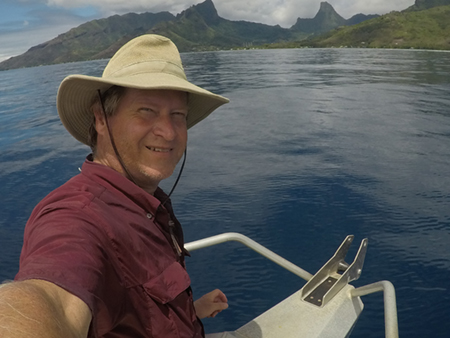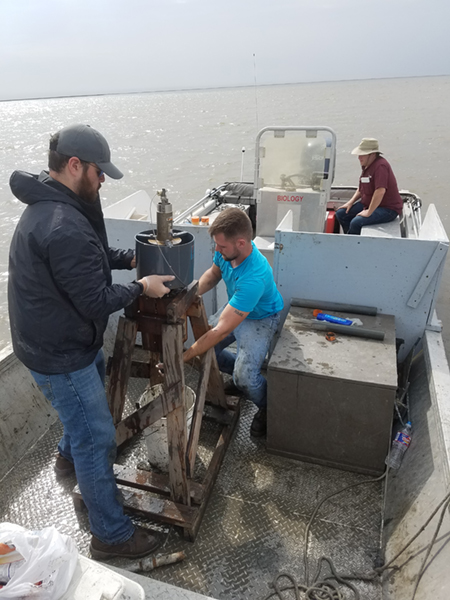Hoch nets grants for coral reef and salt bayou watershed studies
 Matthew Hoch, associate professor of biology at Lamar University, has received two research grants for the study of microorganisms and their effects on coral reefs in Belize and the Salt Bayou Watershed in Jefferson County. His research will help determine what actions can be taken in both locations to reduce the negative impact of human activities on those environments. Hoch has been working with numerous LU graduate and undergraduate students in the research.
Matthew Hoch, associate professor of biology at Lamar University, has received two research grants for the study of microorganisms and their effects on coral reefs in Belize and the Salt Bayou Watershed in Jefferson County. His research will help determine what actions can be taken in both locations to reduce the negative impact of human activities on those environments. Hoch has been working with numerous LU graduate and undergraduate students in the research.
The coral reef microbiology study involved field research campaigns to Belize, Central America, last summer, and Mo’orea, French Polynesia, in fall. Hoch’s funding is part of a $1.36 million grant from the National Science Foundation to collaborators at University of Hawaii, San Diego State University, and University of California – Santa Barbara.
The on-going project focuses on the degradation of coral reefs in the waters off the coast of Belize and Mo’orea. Hoch explained that, because of poor sewage treatment and the over-fertilization of crops, heavy inland rains flush nutrient rich pollutants into river systems and out to sea where they have a grave impact on the coral reef ecosystem. The excess nutrients support the faster growth of macroalgae, such as seaweeds, that, when combined with overfishing of herbivorous reef fish, results in overgrowth of corals by macroalgae.
“So the scenario we have is like if you were to over-fertilize your yard, with plenty of rain, and then never cut it. The herbivorous fish are the lawn mowers of the coral reef and normally contain the amount of macroalgae,” said Hoch.
Hoch went on to explain that, although this in and of itself is a problem, the overabundance of macroalgae can lead to even bigger issues. As they grow, macroalgae leak dissolved organic matter (DOM) into the water as a natural process, like a tea bag steeping in water. Various species of fast growing, pathogenic bacteria take advantage of the DOM to accelerate their own growth, hogging most of the oxygen in the water, to the point that the coral begin to die off both from the disease-causing bacteria and the lack of oxygen.
“That’s our working hypothesis, and we’re trying to understand it in greater detail. For example, different macroalgae produce different DOM, which can affect different bacteria and hence different consequences depending on coral type.” said Hoch. “Once we know what we’re dealing with, there can be some intervention from trying to reintroduce herbivorous fish, which is very difficult to do, or just manually taking out some of the algal growth, or making sure that in those areas they’re not receiving as much nutrient waste.”
 Hoch, along with a team of researches comprised of undergraduate students and faculty from universities in California and Hawaii, continue to study the effects of pollution on the growth of algae and bacteria, and the effects of the algae and bacteria on the coral in the area. Hoch says he hopes to use the grant’s remaining funding to schedule another field research campaign during the summer of 2018 that will carry on the work started by the 2017 trip.
Hoch, along with a team of researches comprised of undergraduate students and faculty from universities in California and Hawaii, continue to study the effects of pollution on the growth of algae and bacteria, and the effects of the algae and bacteria on the coral in the area. Hoch says he hopes to use the grant’s remaining funding to schedule another field research campaign during the summer of 2018 that will carry on the work started by the 2017 trip.
Hoch’s second grant project Coastal Management Program, is funded at approximately $164,000 through the Texas General Land Office. This research project is much closer to home, taking place in the Salt Water Bayou of Southeast Texas, one of the largest coastal marshland areas in Texas. The area is incredibly important for a variety of reasons: it provides protection from storm surge and wave energy during hurricanes, supports both commercial and recreational fishing, and serves as a stopping point for numerous species of migratory birds.
“This area of marshland is basically the whole southern part of our county that includes much of the TPWD J.D. Murphree Wildlife Management Area, Sea Rim State Park, USFWS McFadden Wildlife Preserve, and Jefferson County lands. So, we have a lot of economy wrapped up in our marsh. It’s a tremendously valued resource in our area that’s managed by county, state, and federal agencies,” said Hoch.
However, over past decades, the Salt Bayou Watershed has been heavily affected by human activity. Oil and gas extraction has been closely linked with land subsidence in the area and, when combined with sea level rise due to climate change, has caused the overall water level to increase to levels that stress the growth of certain marsh grasses.
“You have the sea level rising and the land sinking, so what we call the relative sea level rise - the combined effect - is much greater. There are areas that have been going underwater by about a centimeter a year. And that may not sound like much, but over a decade that’s four inches or so,” said Hoch.
The addition of more sea water to the marsh, as well as the fact that man-made shipping canals have cut off much of the fresh water supply to the area, means that the overall salinity of the water in the marsh has become too great for many marsh grasses. Choked with salt and flooded with water, these grasses die and leave the soil where they once stood vulnerable to erosion, resulting in fragmentation of the marsh into small, open puddles instead of solid soil, and eventually larger shallow ponds.
Hoch is a member of the Salt Bayou Watershed Restoration Workgroup, comprised of county, state and federal resource managers and academic researchers seeking a solution to this problem. “Recently we’ve been trying to coordinate a plan for monitoring the health of the marsh while some of the efforts to change the conditions are undertaken,” said Hoch. “One of the biggest projects that is planned is to actually put in a grouping of big pipes, called inverted siphons, that will go underneath the Intracoastal Waterway (ICWW). These pipes will bring freshwater flows from the north, down underneath the ICWW, and back up and out to the southern side marshlands.”
Current research in the Salt Bayou Watershed is baseline study of conditions of the estuary (Keith-Johnson-Shell Lakes) and the marshland sediments prior to the installation of inverted siphons. Hoch explained that the LU Center for Advances in Clean Air and Water (CAWAQ) contributed instrumentation to begin a partnership with Jefferson County engineers to commit to continuous monitoring of salinity in the watershed in support of their grant application for inverted siphon funding. Hoch and a team of student workers and volunteers have been continuous monitoring water quality, as well as studying the microbial communities of bacteria and algae in the estuary quarterly since summer 2016.
“Receiving funding from the Texas GLO in October 2017 is a reward for our investment,” Hoch said, “and it will support more detailed analyses and student opportunities through spring 2019.”
He doesn’t plan to stop monitoring the marsh even after the inverted siphons are installed, however. “We’re monitoring before they go in as well as during and after so that we can see the effect and learn how to properly operate the system. Are there times where we need to let more water through? Or less? So, a big part of our work is to monitor what’s going on.”
For more information on the degradation of coral reefs and the importance of Hoch’s research, students and the public are invited to attend a free screening of the documentary “Chasing Corals” that will take place April 17 at 7 p.m. in the Price Auditorium, John Gray Center on the LU campus. A discussion panel that includes Hoch and students who accompanied him on the 2017 research trip to Belize, LU professors Harley Myler and Ana Christensen, will follow the screening. Joining as keynote for the event will be marine ecologist Joanie Kleypas, a Lamar University alumna and internationally recognized coral researcher.


